-
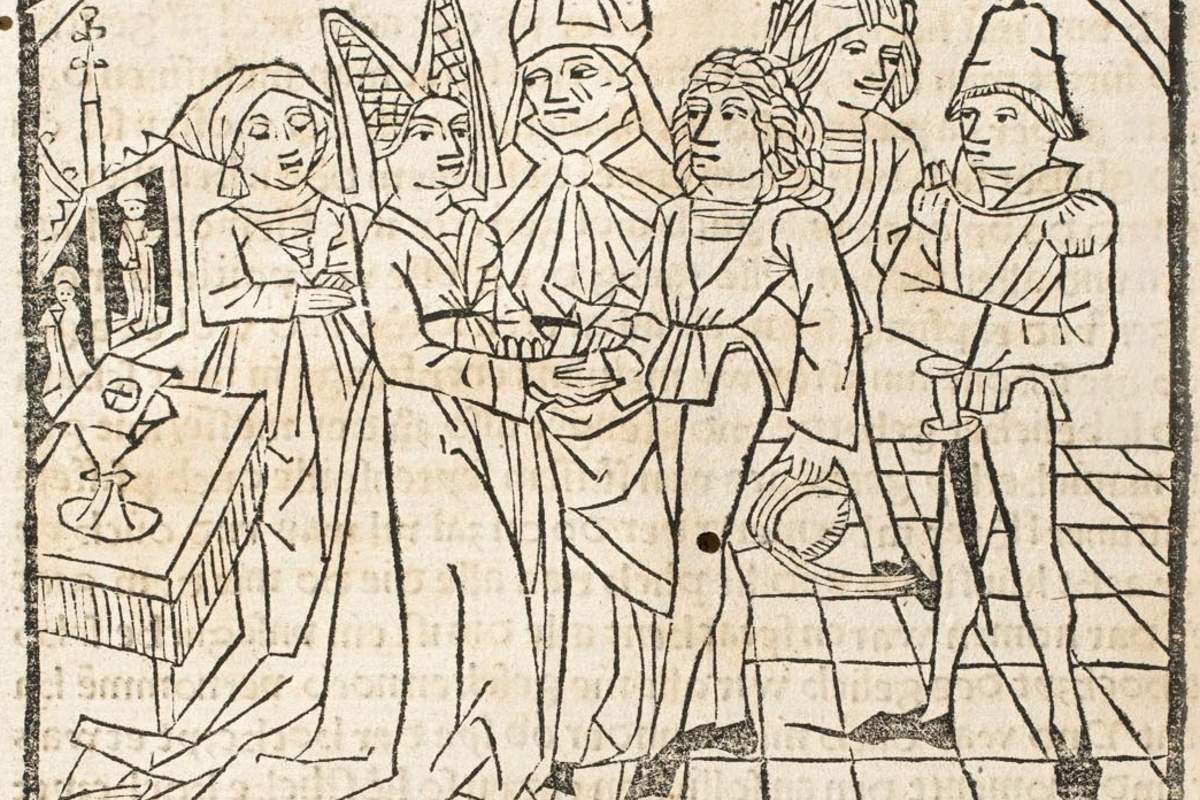
What have Alexander the Great, the mermaid Melusine, and Lucifer’s lawyer in common? Their fascinating stories can all be found in this brilliant Sammelband (a collection of multiple works), bringing together 6 of the most popular German literary texts of the late Middle Ages.
-
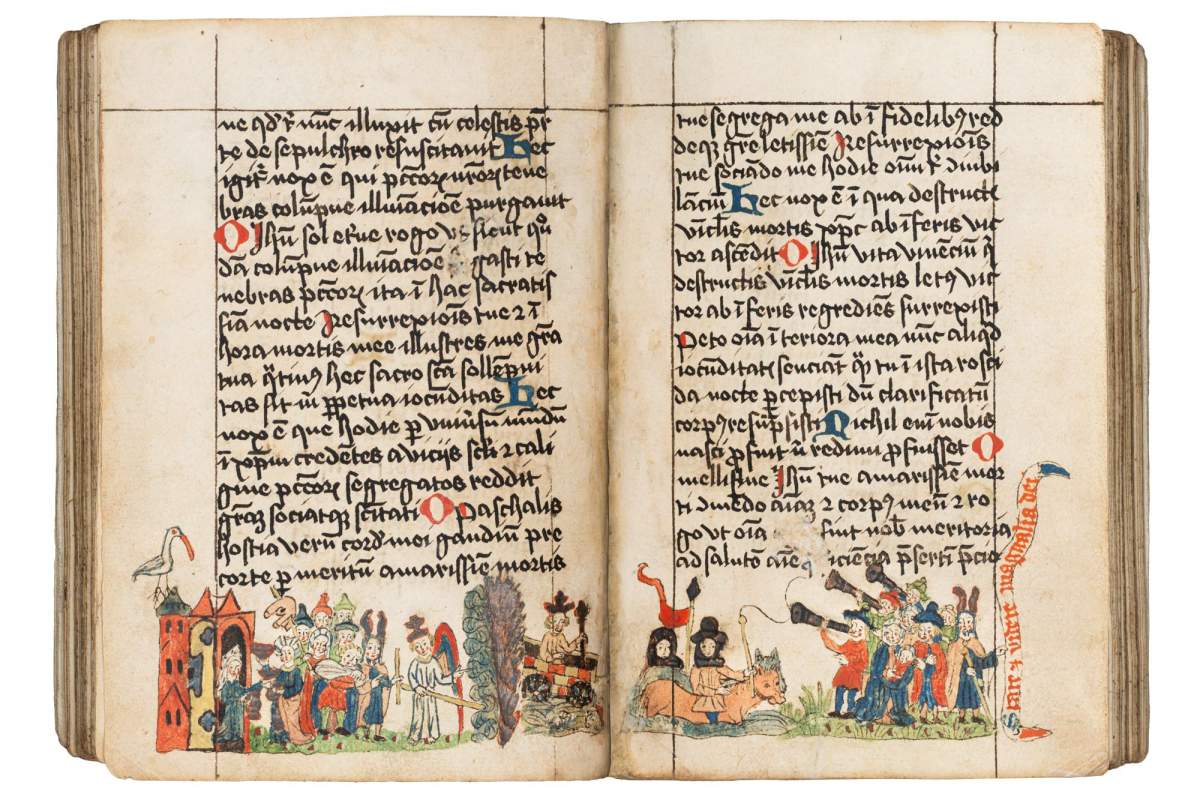
-
 Dr. Jörn Günther Rare Books returns to TEFAF this year with a splendid selection of precious manuscripts and rare books. Our highlights this year are three outstanding manuscripts that convey the breadth and beauty of medieval manuscript illumination and carry prime historical significance, making this a truly splendid selection.
Dr. Jörn Günther Rare Books returns to TEFAF this year with a splendid selection of precious manuscripts and rare books. Our highlights this year are three outstanding manuscripts that convey the breadth and beauty of medieval manuscript illumination and carry prime historical significance, making this a truly splendid selection. -
A Star over Basel
City of Culture and Historical Treasures
Since the 5th century B.C., the area at the bend of the Rhine, on which the city of Basel now stands, has been inhabited. First by Kelts, but not much later, the Romans discovered the lovely and strategically beneficial spot. The actual name of the city Basilia was first mentioned in the 4th century. In our blog post, however, we will focus on another time, namely 15th century, when Basel became a European centre of book art. When we look at the festive lights around the hill of the cathedral and the Christmas market on Barfüsserplatz, it is not difficult to picture ourselves in the epoch of faith, hope, and - alas - unfathomable fears: the late Middle Ages.
-

In our newest video series, we are showcasing our three splendid highlights for this year’s Frieze Masters in London: The Liechtenstein Tacuinum Sanitatis, the Warburg Rosarium, and the Great Hours of Galeazzo Maria Sforza.
-
Popes, Conversos, and the Eternal City
Cardinal Juan de Torquemada (1388–1468)
In our newest blogpost, Oxford Dphil. cand. Eduardo Benítez-Inglott y Ballesteros, discusses the author of the Meditationes seu contemplationes devotissimae, Cardinal Juan de Torquemada. One of the most outspoken papal apologists at the height of the ecumenical councils of the early fifteenth century, he also advocated for the rights of Jewish converts in the Spanish Crown of Castile. We are delighted to be able to offer the first edition of the Meditationes seu contemplationes devotissimae using metalcuts, printed in Mainz by Johann Numeister .
-
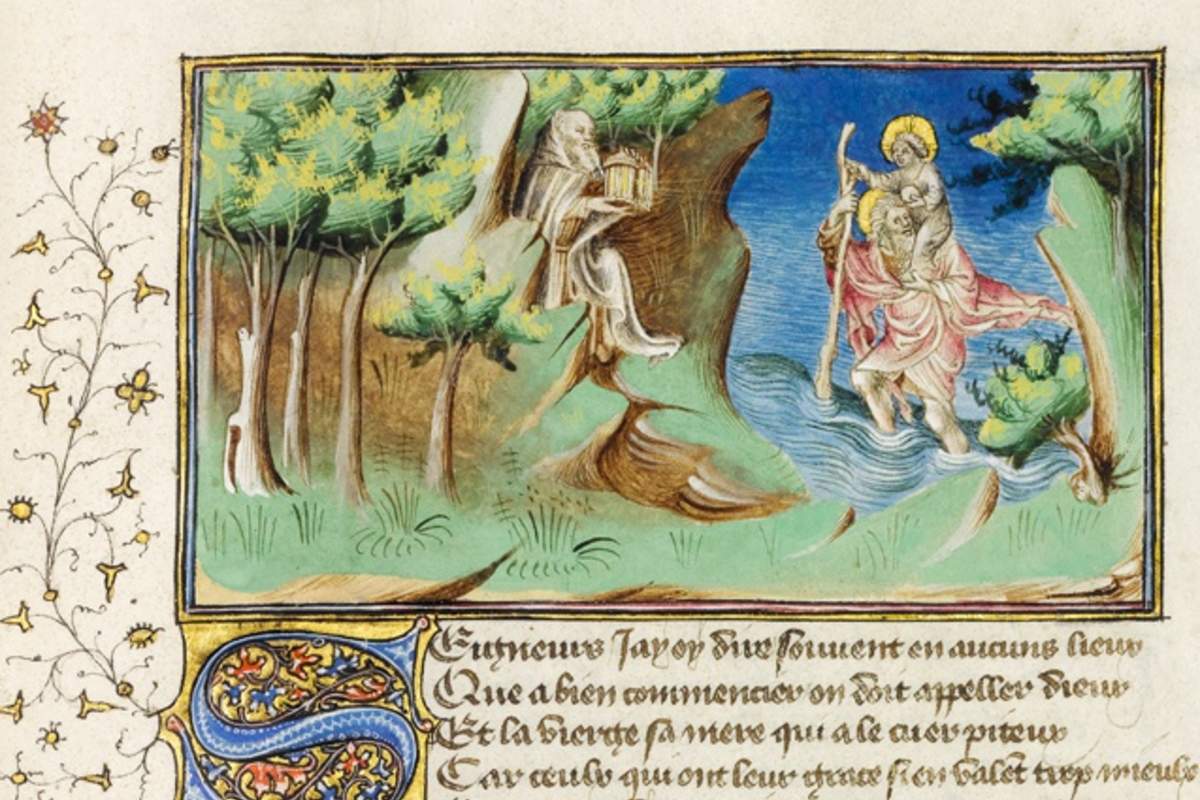
This fascinating narrative Bible was illumianted by the Master of the Berry Apocalypse in Paris around 1416. In three parts, Dr Sara Öberg Strådal introduces this stunning book and the artist, the book itself, and the stories within.
This stunning manuscript will be on display at our stand B-15 at the New York Book Fair.
-
Videos of a unique Book of Hours
This manuscript illuminated by the Master of Francois de Rohan is now sold.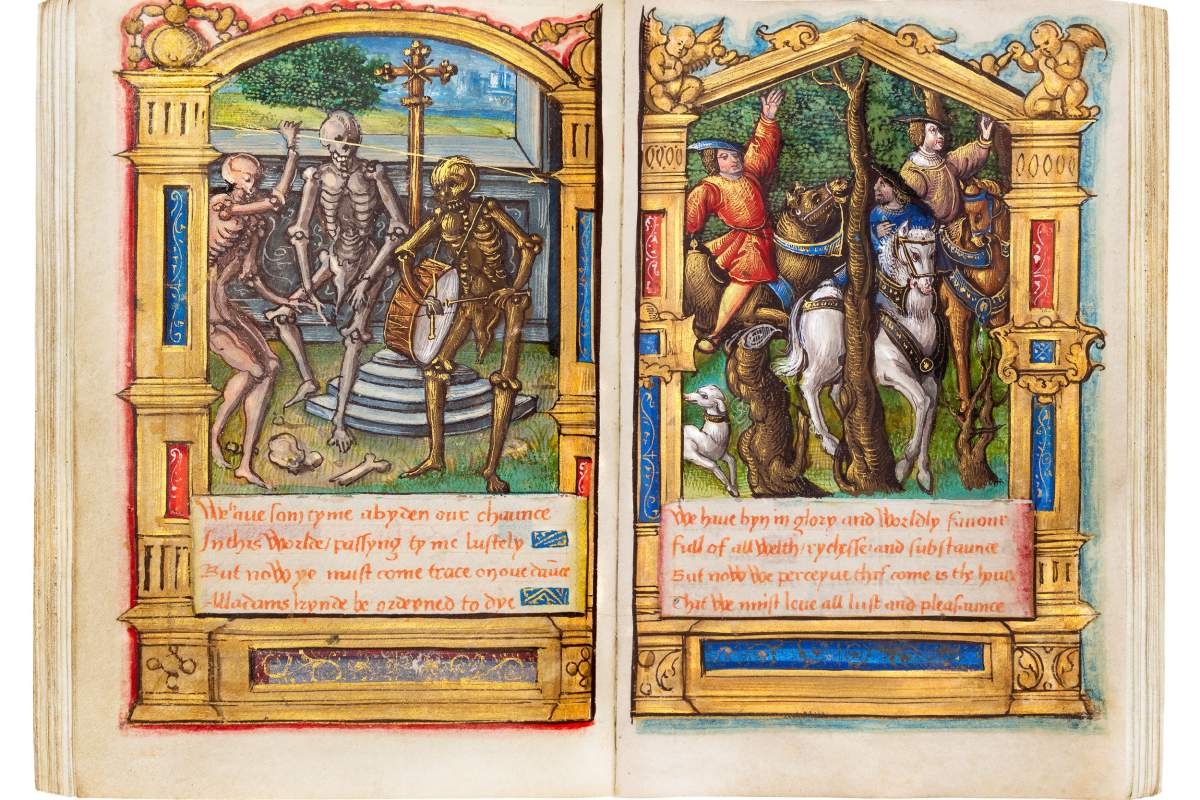
This beautiful manuscript is the work of the Master of Francois de Rohan and one other artist. In this first of three videos, Dr Ina Nettekoven introduces this wonderful little prayerbook which was produced in Paris for the English market in the first half of the 16th century. This fantastic book was on display at our stand at TEFAF Maastricht, in March, but is now sold to a private collector.
-
Videos on a very special Psalter
Three videos focusing on different aspects of a Psalter by the Franciscan Master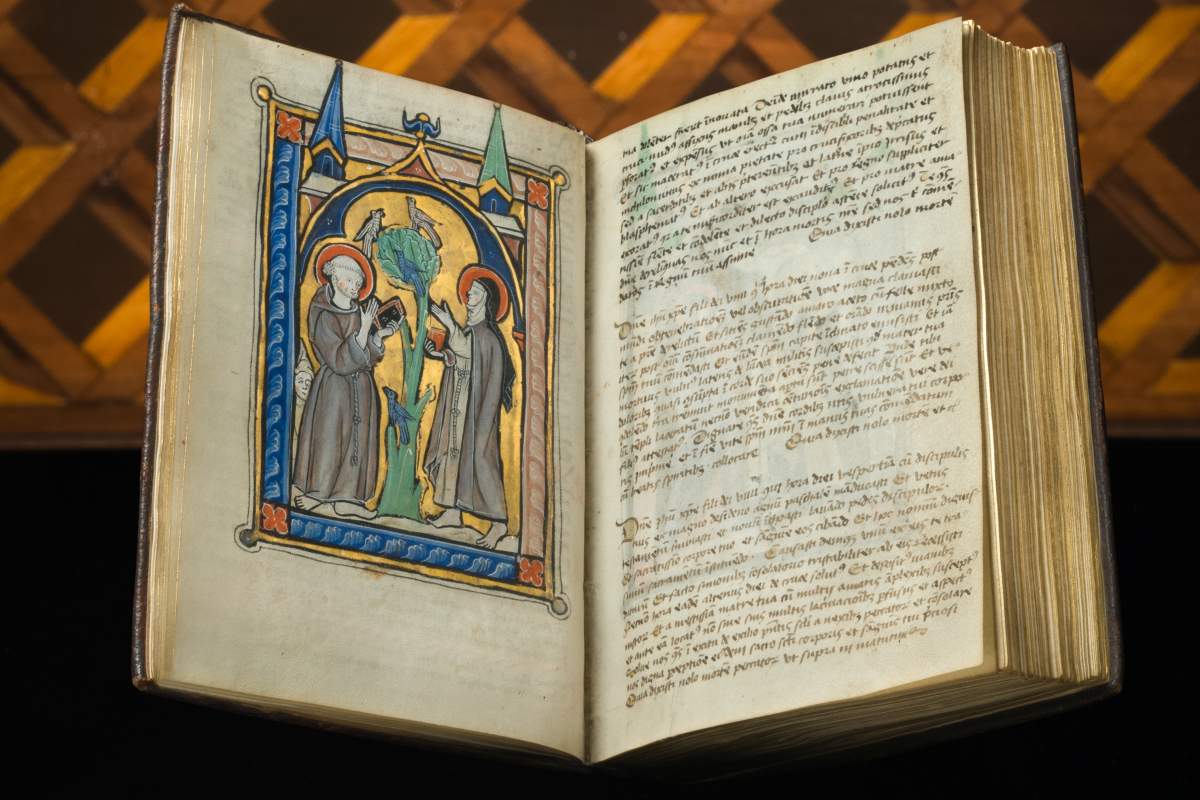
In the first of three videos, Dr Sara Öberg Strådal introduces this enchanting little Psalter illuminated by the Franciscan Master of Bruges in the middle of the 13th century.
-
Christmas
everything you always wanted to know about it Collage with Christmas Scenes
Collage with Christmas ScenesIn Luke's Gospel (2:1-20), the story of Christ's birth is told. Most of us have known it since childhood:
In those days Caesar Augustus issued a decree that a census should be taken of the entire Roman world. This was the first census that took place while Quirinius was governor of Syria. And everyone went to their own town to register. So Joseph also went up from the town of Nazareth in Galilee to Judea, to Bethlehem the town of David, because he belonged to the house and line of David. He went there to register with Mary, who was pledged to be married to him and was expecting a child.
-
The Post-Gutenberg Era
Early Printed Bibles in German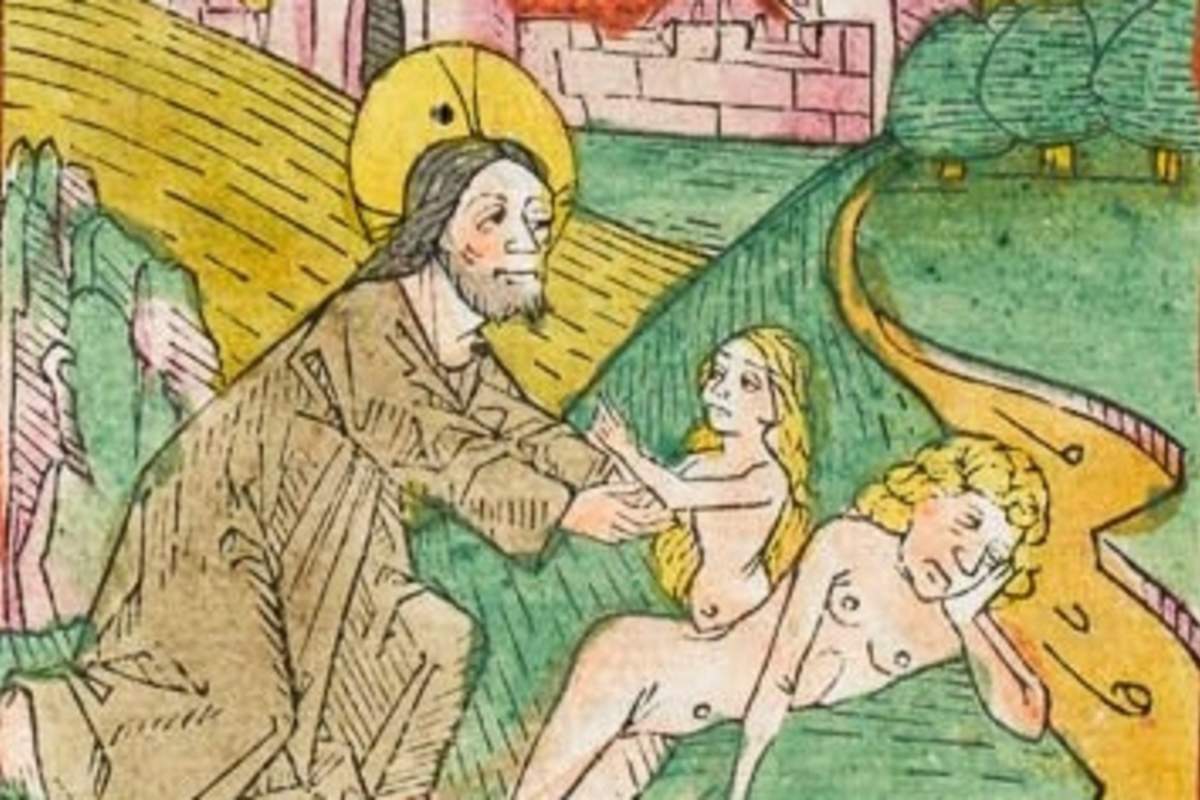 Creation of Eve from Pflanzmann's German Bible of 1475-77
Creation of Eve from Pflanzmann's German Bible of 1475-77The first book to be printed with movable type printing was a Bible - the Book of Books. Around 1454/55, Johannes Gutenberg from Mainz set about the daunting task of printing a Bible with 324 pages in folio format. Gutenberg's Bible was printed in Latin. Not long after his first printing adventure, other printed Bibles followed in Latin and in German.
Obviously, public demand was great.
-
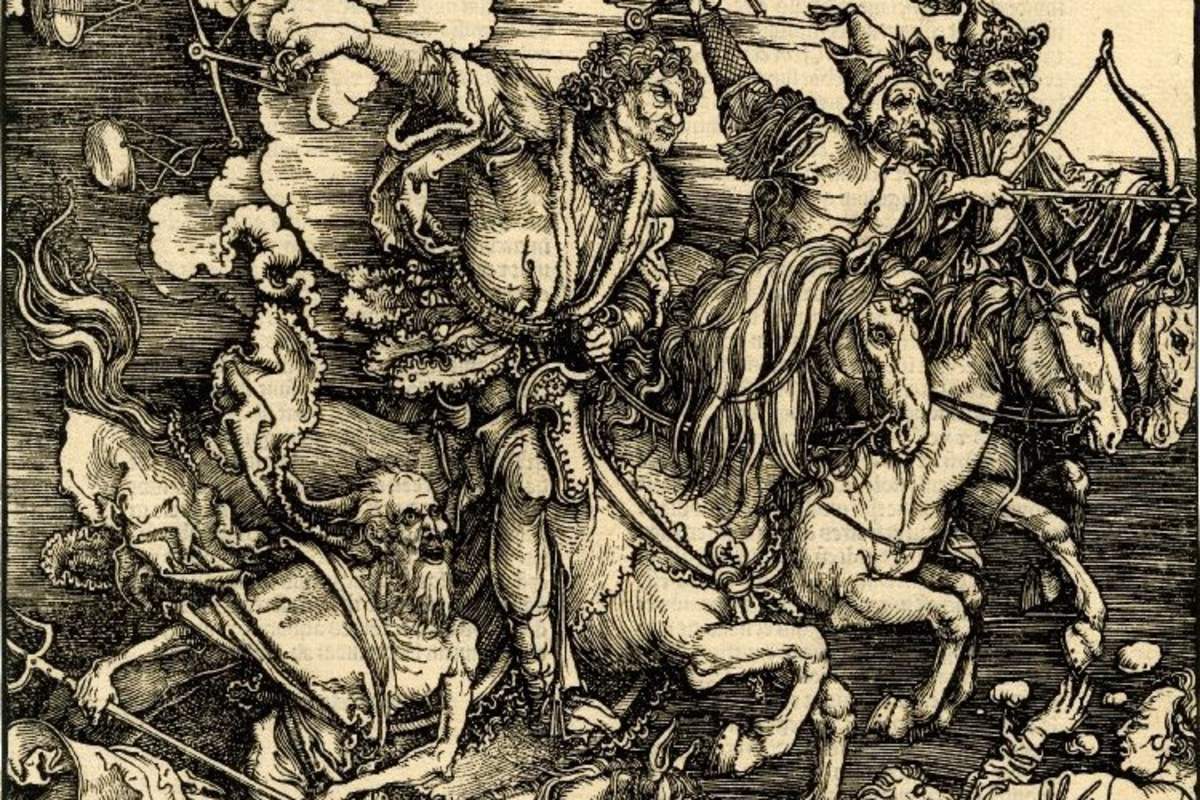
-
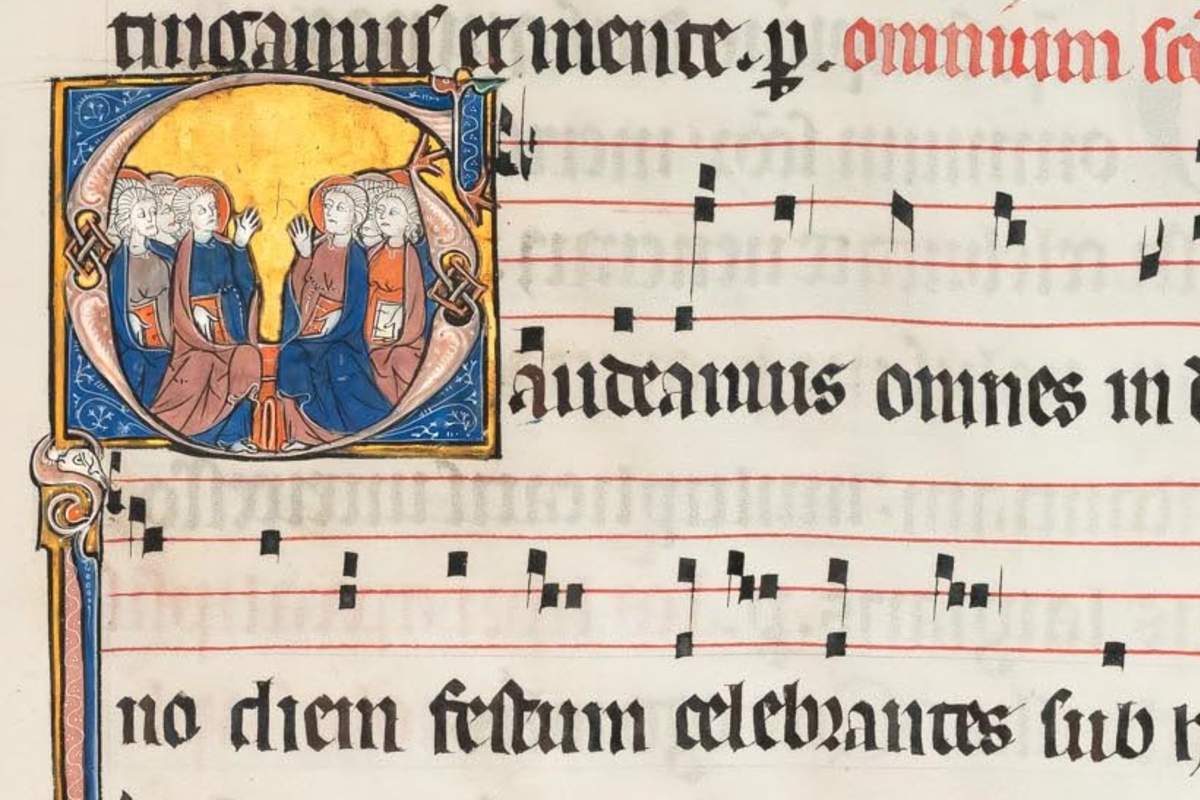
-
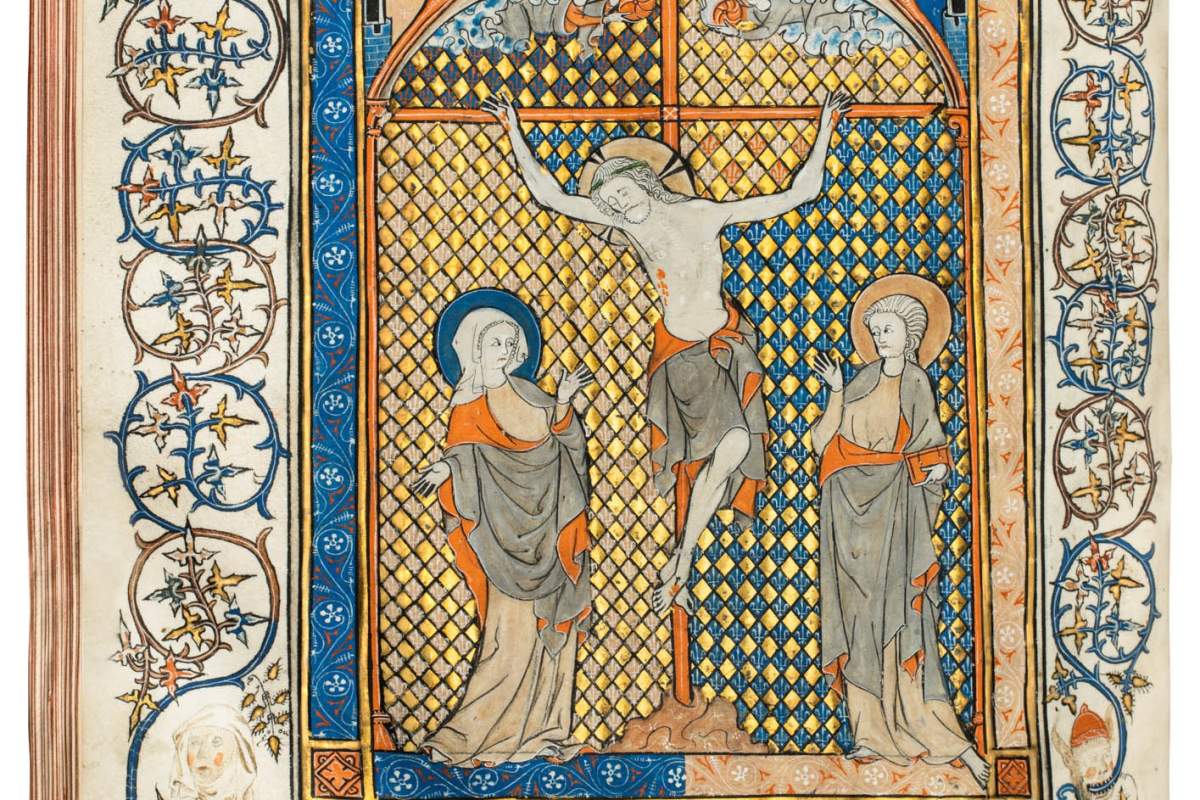
After expanding from London to include fairs in both New York and Los Angeles, the first ever Frieze Art Fair in Asia is due to open Seoul in September.. This contemporary art fair will present some of the most impressive and groundbreaking art produced across the globe. Similar to Frieze London, which is accompanied by Frieze Masters showcasing the history of art from which contemporary artists have developed and with which they remain in dialogue, Frieze Seoul also includes a smaller Masters section. Alongside the impressive repertoire of contemporary pieces, 18 galleries will exhibit historic works of art. One of these galleries is Dr Jörn Günther Rare Books. -
Sales to the Metropolitan Museum of Art Continue to Inspire
Two manuscripts sold by JGRB to the New York Institution are examples of a continued fascination with manuscript art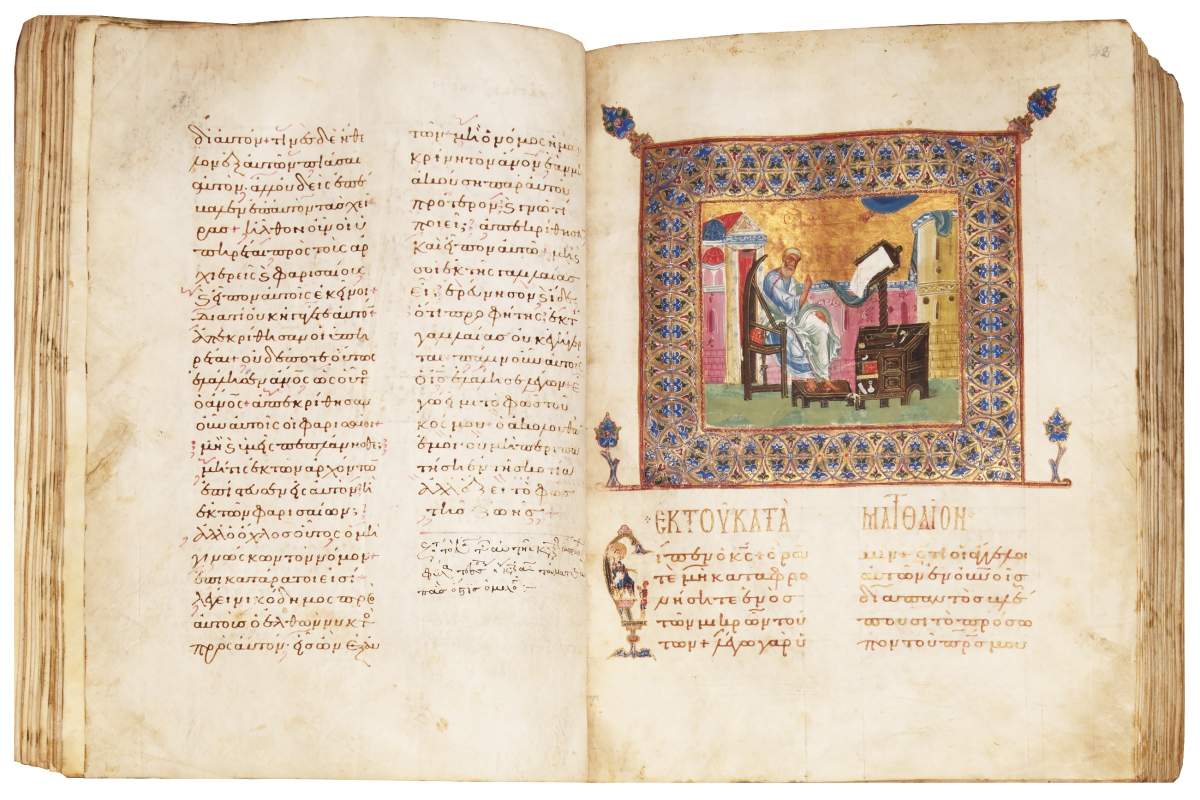
Two manuscripts sold by JGRB to the New York Institution are examples of a continued fascination with manuscript art.
-
New Acquisitions coming to Frieze Masters 2021
Some October Updates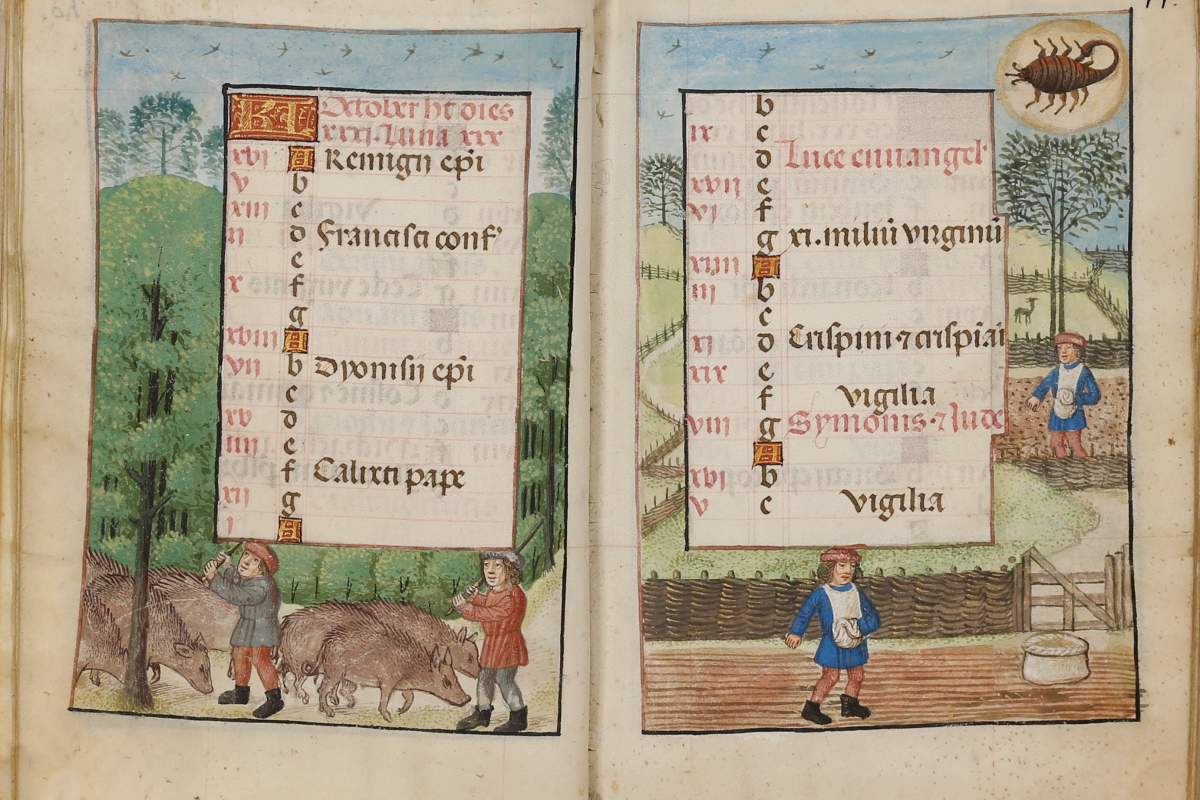
It's an exciting time for Dr Jörn Günther Rare Books, with the publication of our new brochure, Collecting Culture, imminent and the upcoming Frieze Masters in London, our first in-person event after so long away.
-
The Life of a Manuscript
The Collection History of a Book of Hours, use of Sarum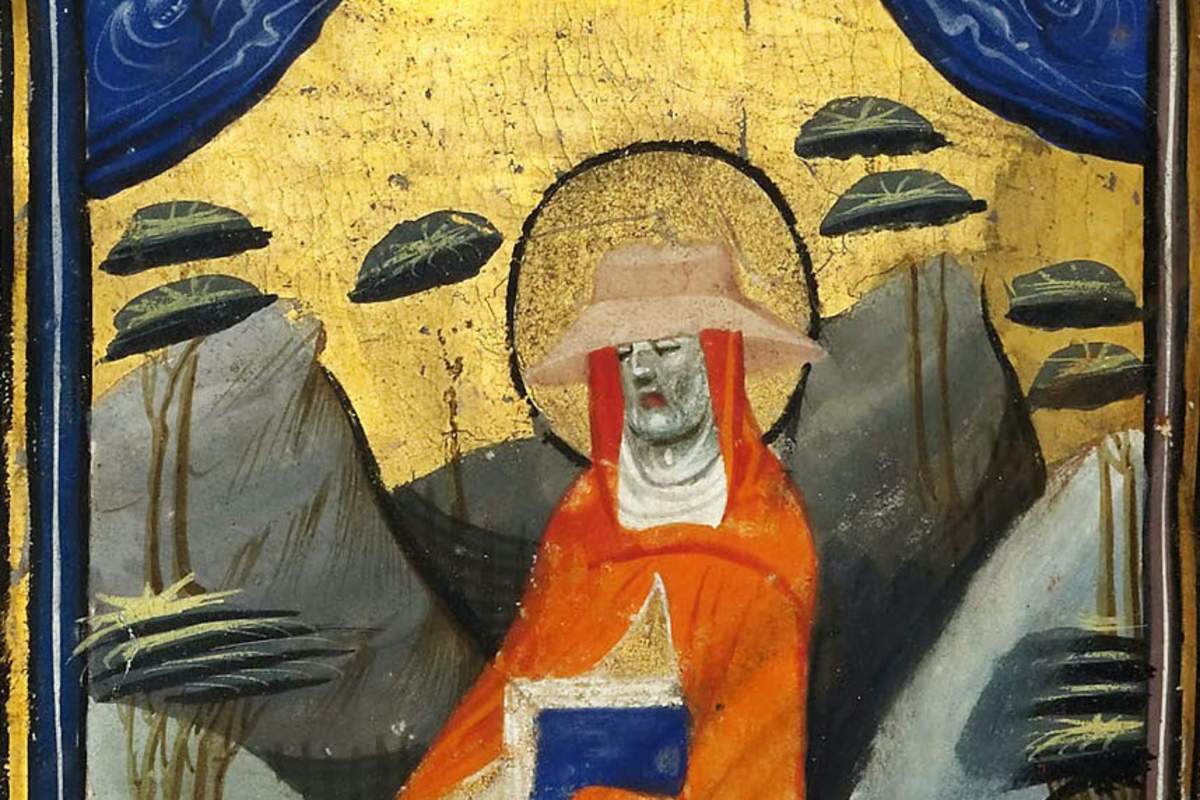
Continuing our series exploring the life of a particular object, we look at the history of this Book of Hours, Use of Sarum (Bruges, c. 1430), illuminated by the Masters of Otto van Moerdrecht. This elaborate prayer book has a fascinating history, having moved in the circles of politically and socially important collectors.
-
The Life of a Miniature
A new blog series focusing on an item's collection history
A new blog series focusing on an item's ownership history.
The Life of a… series will focus on a particular item, the hands it has passed through and the eras it has survived. When viewed alone, it is easy to become caught up in a manuscript’s beauty, as well as its many intricacies, but it is worth remembering that all of the objects that survive from the Middle Ages and Renaissance have endured a great deal of history. -
 Mountnorris Book of Hours
Mountnorris Book of HoursArt fair visitors often approach us at our stand and say to us:
"I am interested in collecting medieval illuminated manuscripts, but I'm not sure where to begin."
First and foremost, you should love the artworks with which you live, so we always advise you to get a good sense of what aesthetic styles and what themes attract you the most. From there, knowing your budget is also essential. Below, you will find our Top Ten suggestions for great works of illumination that are perfect for the beginning collector. -
Britannia and Hibernia – on the edge of the world
If you are curious as to their beauty...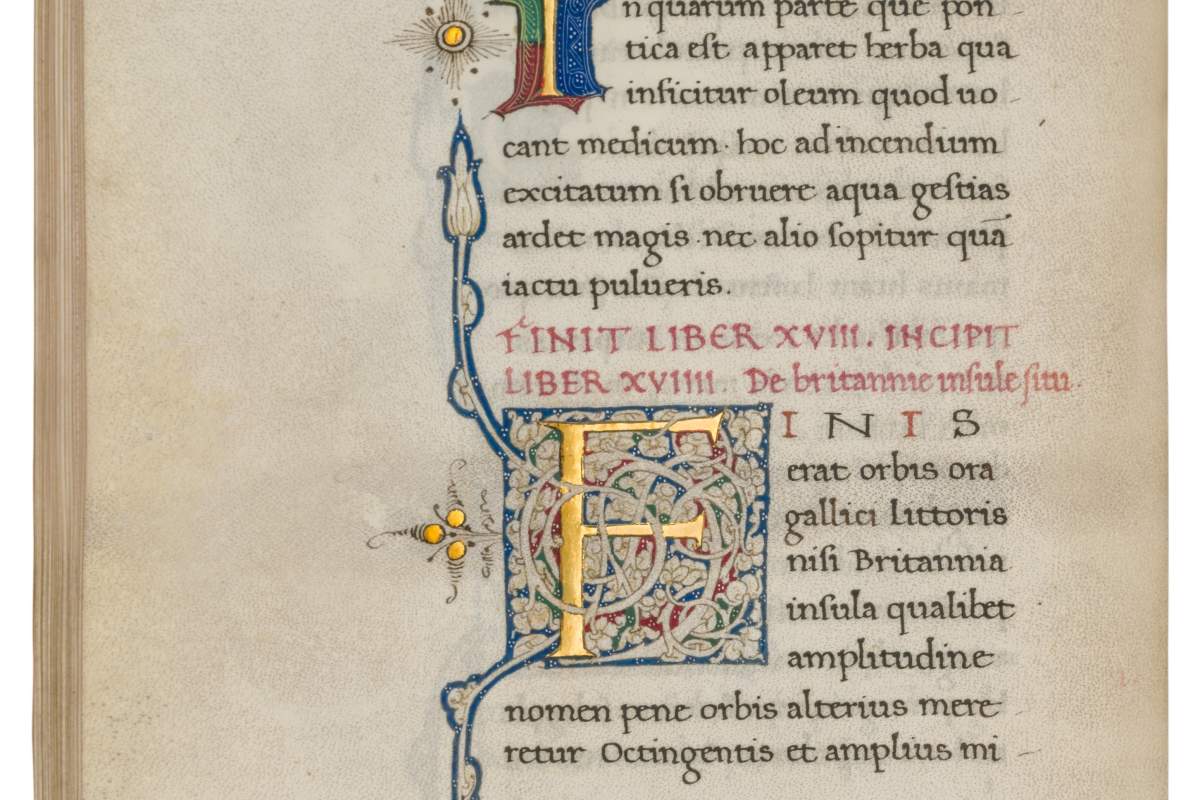 Solinus, Beginning of the description of Britannia in Book 18
Solinus, Beginning of the description of Britannia in Book 18While strict rules on social distancing apply, not being able to travel may hurt bibliophiles less than others because they know how to travel through books. Sitting in a comfortable chair with a beloved book in our hands, we are transported into off-road adventures. Our medieval manuscripts can spirit us away in an instant. This is the second blog post on Dr. Jörn Günther Rare Books' fine manuscript of the Collectanea rerum mirabilium or Polyhistor by Solinus, a 3rd century Roman geographer. With this book as our point of departure, we embark on exciting journeys and come home again.
-
Travelling in time and space
Looking into an enjoyable manuscript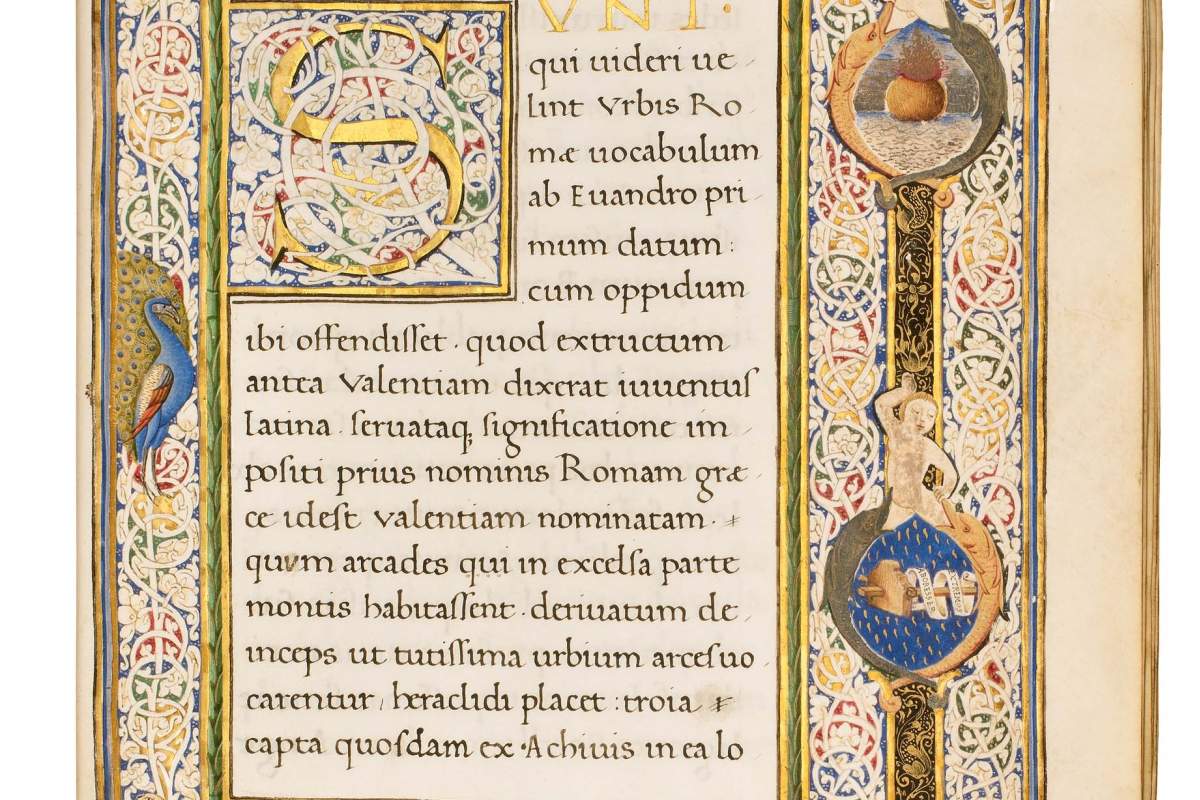 Solinus, Collectanea, f.7r with coat of arms in lower margin
Solinus, Collectanea, f.7r with coat of arms in lower marginNot being able to travel, since borders are closed and strict rules on social distancing apply, may not hurt bibliophiles as much as others. The more so, since we know that books allow us to travel while staying safely at home, each and every day. Relaxing in a comfortable chair, we can take a book in our hands, and soon we are transported into off-road adventures. With our medieval manuscripts we can be spirited away in an instant. In this series of blog posts, we will share some exciting journeys.
-
Felix Arabia
Travelling with Solinus in hand Solinus on Arabia in our Latin manuscript Liber 28
Solinus on Arabia in our Latin manuscript Liber 28This is the third blog post of our series, in which we take Dr. Jörn Günther Rare Books' fine manuscript of the Collectanea rerum mirabilium, or Polyhistor, by the 3rd century geographer Gaius Iulius Solinus, as a point of departure. W:ith Solinus in hand, we embark on exciting journeys and come home again. This time he brings us to Arabia.
-
Frequently Asked Questions
Q & A on Manuscripts, Miniatures, and Early Printed Books
Questions we get asked most frequently include the following:
How do rare books, manuscripts, and miniatures fit into the field of art and antique collecting?
What are some of the most common misconceptions about the world of rare books and manuscripts?
How do collectors live with these objects? Given the age of some of these works, how careful do owners have to be in interacting with and maintaining them?
-
Three Magi
How wise men from the Orient ended up in Cologne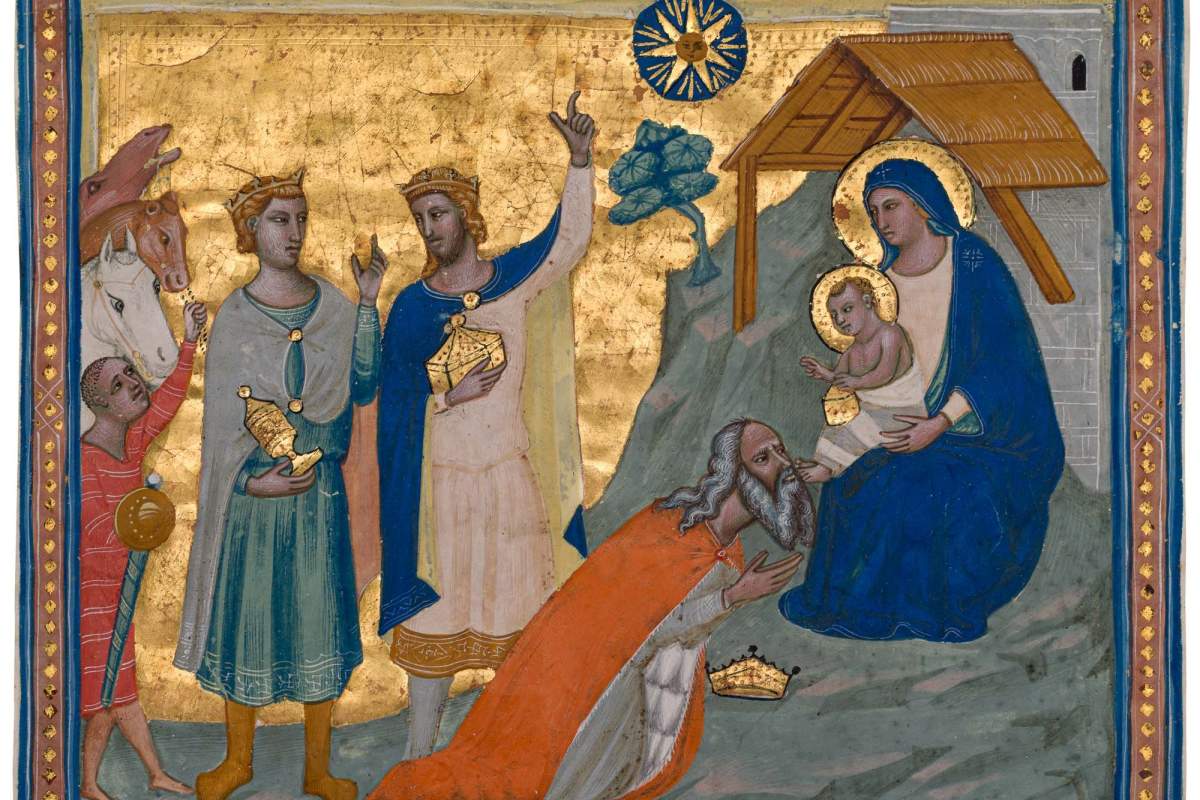 Pacino da Buonaguida, Florence, c. 1330-40, private collection
Pacino da Buonaguida, Florence, c. 1330-40, private collectionTheir story is known by more than a billion people all over the world: Three Magi travelled from the Orient to Bethlehem guided by a star. They found the Christ Child in a humble stable lying in a manger and brought him gold, incense and myrrh. Their story is told quite concisely in Matthew's Gospel 2:1-12. But there is another more detailed and far more embroidered narrative on the events before, during, and after the three magi encountered the Holy Family. It was written by a German Carmelite monk, called Johannes of Hildesheim. His tale is lesser known but very elucidating.
-
Perspectives of all times
A fabulous collection in perspective New brochure on perspective
New brochure on perspectivePerspective is the art of representing the world in the way the human eye perceives it. Questions of visual perception and spatial arrangement have continuously been discussed and remain relevant, whether in surrealist painting, in constructivism or in any other geometrical abstraction or exploration. Space and methods of placing people and objects in perspective have been explored in the past and continue to preoccupy artists to the present day. In our new brochure titled Perspectives: A special collection of artist's manuals on perspective and human proportion, we offer an exciting collection of fifteen very rare, early printed books about the invention of 'perspective' by and for artists.
-
Impressive script
Inspirational and lasting examples going back to Roman days
The script that we use in the West – as well as many other things – goes back to Roman times where we can find the inspirational and lasting examples. By the first century CE, when most of western Europe was part of the Roman Empire, the authorities had widely adopted the use of Latin. At the time, the Roman Latin alphabet and script gave us imperial capitals carved in stone, rustic capitals painted on walls, and cursive script handled for daily writing. From this cursive script, uncial lettering developed that showed disconnected, capital letters without word separation. In the 4th century, when Roman power collapsed, and the Christian faith had been adopted, the art of writing became more and more confined to the monasteries. In the monastic environment, scripts developed local peculiarities and transformed into writing that often became difficult to read outside the immediate context. Thus, writing abilities diminished and texts deteriorated to such extent that by the middle of the 8th century, the call for standardization and readable texts could no longer be ignored. In order to be able to establish reforms, Charlemagne (742-814) requested scholars to develop a new script. Around 780, the scholar Alcuin of York designed what is known as the ‘Carolingian minuscule’, a script that soon became the standard in Charlemagne's empire.
-
Heroes, but what about Heroines? – Part II
Stephen Fry retells how Theseus falls in love with Ariadne but leaves her behind, heartbroken and devastated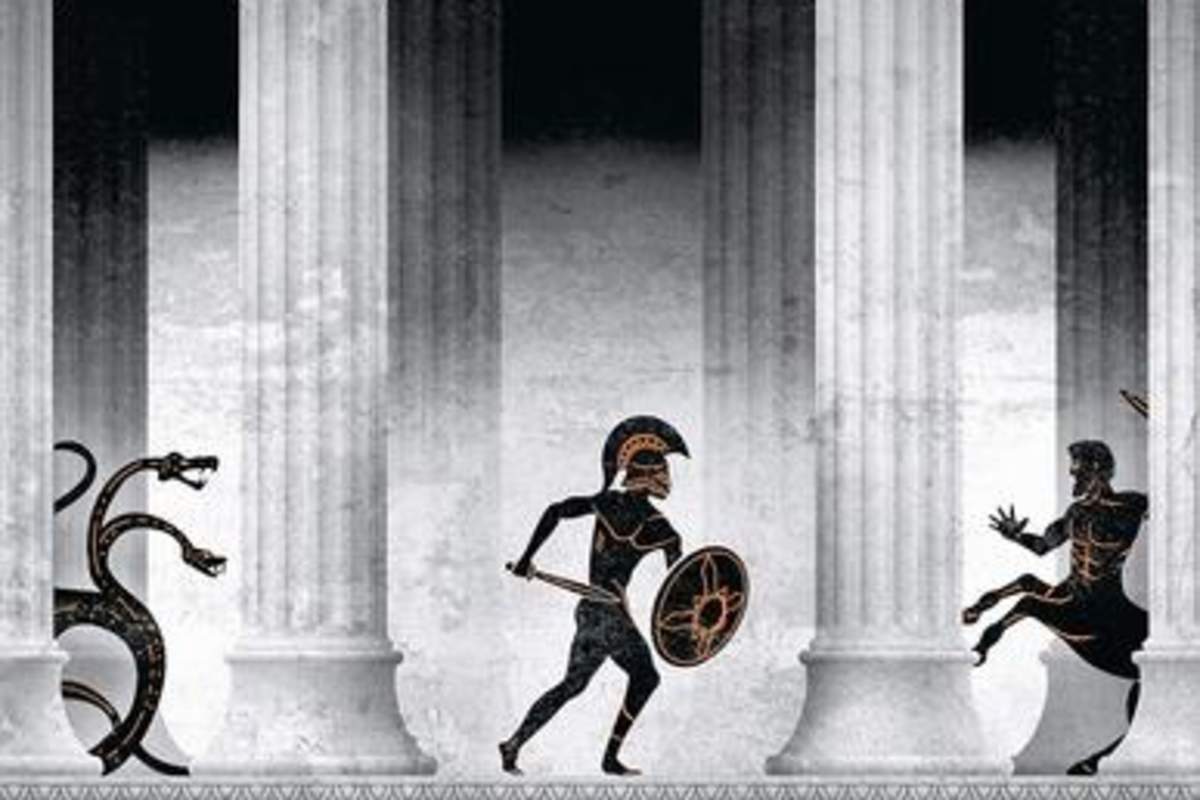
As a follow-up to his bestselling Mythos, Stephen Fry brilliantly retells the tales of Greek heroes in his new book, Heroes. Mortals and Monsters. Quests and Adventures. This time, Fry enters the Age of Heroes – where heroines are not far away. In a ‘twisted labyrinth’ and with a ‘blood-curdling monster’ called the Minotaur, Theseus with the help of Ariadne slays the man-eating creature. Before that he had promised her ‘you will sail with me back to Athens and we shall rule together as king and queen.’ By following the thread (a ruse made up by Ariadne), he found his way out of the labyrinth again – back to Ariadne (Fry, p. 377).
-
Heroes, but what about Heroines? – Part I
Stephen Fry joins Jason aboard the Argo – after retelling the adventures of the Greek Gods in ‘Mythos’, the famed English author turns to the tales of Greek heroes
As a follow-up to his bestselling Mythos, Stephen Fry brilliantly retells the tales of Greek heroes in his new book, Heroes. Mortals and Monsters. Quests and Adventures. This time – and with the Gods still very much around – Fry enters the Age of Heroes. But in the male dominated world of heroes, heroines are not far away. The heroic stories of Antiquity – just think of the adventures of Jason, Theseus, Aeneas – became all-time bestsellers that have since become the subject of the most elegant manuscripts, tragic operas, romantic paintings and now, Stephen Fry's popular books.
The Roman author Ovid (c. 25-16 BC) wrote a series of fictional epistolary poems, titled Heroides (= Heroines), from the perspectives of famous heroines of Antiquity. In these letters, the women pour their hearts out to their heroic lovers – who sadly had abandoned them. With this work Ovid created a new genre of texts that greatly contributed to the fascination with these heroines throughout the ages, drawing new audiences everywhere, amongst others at the royal court of France.
-
Perpetuating 'memoria'
An industrious and affluent citizen striving for his memoria St. Sebald with donors dd 1502
St. Sebald with donors dd 1502Nuremberg at the end of the 15th century, was one of the most bustling and industrious cities in Europe. With its vibrant art scene, its flourishing industrial areas, and devotional activities throughout the city, it attracted many visitors. From far, travellers would recognize the towers of St. Lorentz's and St. Sebald's, the two most important parish churches of the town that were also highlighted in Hartman Schedel’s world chronicle (Nuremberg, 1493).
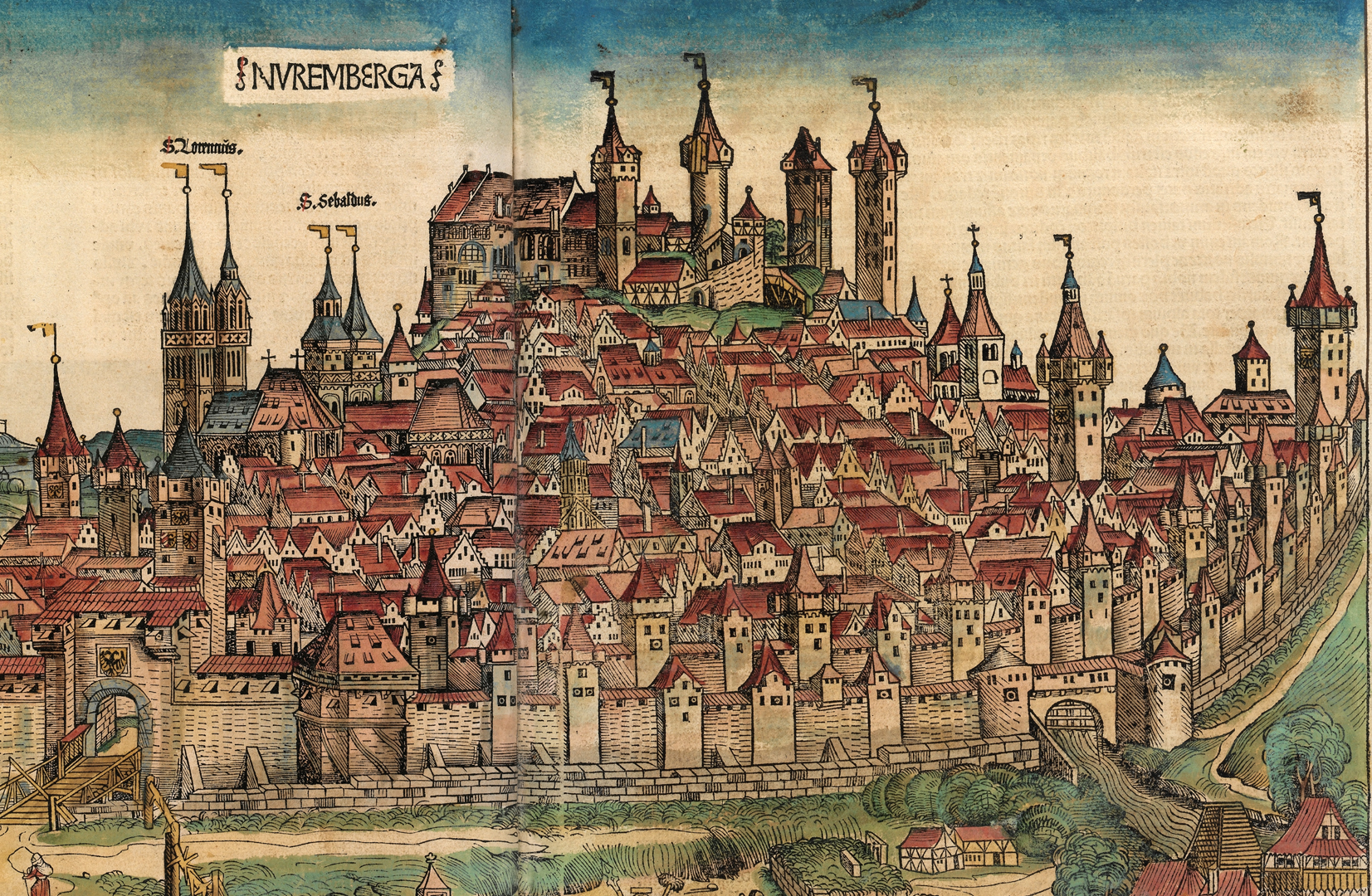
Schedel's Chronicle was financed by Sebald Schreyer and his brother-in- law, Sebastian Kammermeister. Schreyer, in particular, was involved in various book productions.
-
An enigmatic interpretation? Two devices explained.
A nautical staff known as balastella, fore-staff or Jacob's staff
The fine humanist manuscript of Solinus' Collectectanea rerum memorabilium ('collection of memorable things') is most elegantly executed. When we were analyzing the book, the devices on the openings page of the text remained unexplained. Here we try to solve the enigma.
The script of the book is attributed to Giovanni Marco Cinico, the highly appreciated royal copyist and librarian at the Aragonese court in Naples, who likely collaborated in this manuscript with Cola Rapicano, the official illuminator in Naples from 1451 to 1488. Without sparing material, the scribe and illuminator together created an extremely fine and beautiful book.
-
An astonishingly fine Bible
Challenging images for a exigent commissioner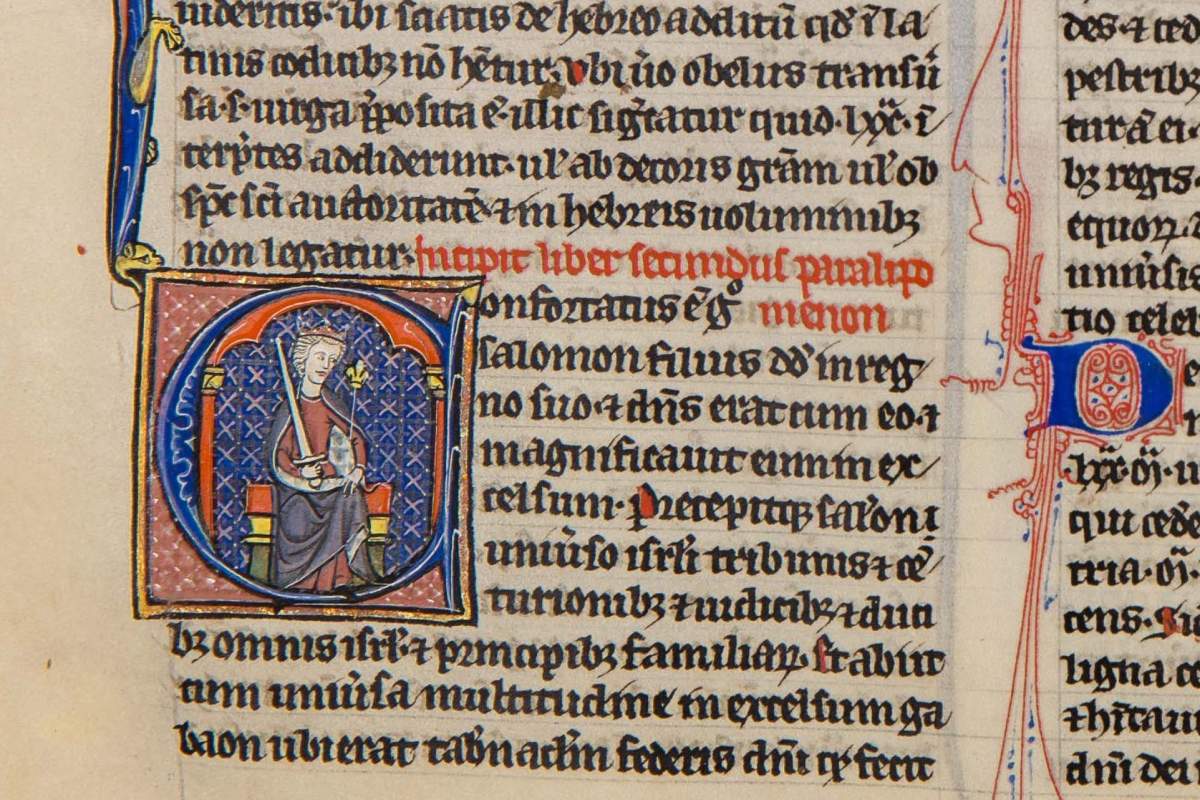
During the first half of the 13th century, Blanche of Castile (d. 1252), queen and queen mother of France, often resided in Paris. Her patronage of illuminated manuscripts was extensive and refined, for which she is called “the first important royal patron of the thirteenth century”. In overseeing the education of her children she exhibited a compelling concern for their spiritual welfare. Of the six of her children who survived childhood, Louis IX and Isabelle of France, reached sainthood. Her dedication as a mother and educator is recorded in various works of art. Presumably, the famous manuscripts of the Bible Moralisée were produced for the French royal family under her patronage. These were quite innovative works with a didactic function. As Queen of France and twice regent (the second time when Louis IX was on crusade, 1248-1254), it was through her extensive patronage of art that Blanche had lasting effect. The queen is also considered to have been patron to the design of the Sainte-Chapelle (1238-1248). In that royal chapel as well as in manuscript illumination, the fleur-de-lys symbol is omni-present.
In the illuminations in our Parisian Bible (illuminated by an artist of the Royal Psalter Group), royal power is expressed in the fleur-de-lys at King Solomon (f. 139v), at Cyrus king of Persia ordering the building of the Temple (f. 152r), and in the image of King Artaxerxes (f. 155r).
-
A painted Christmas tale
A tantalizing page from a 15th century Swiss-German Breviary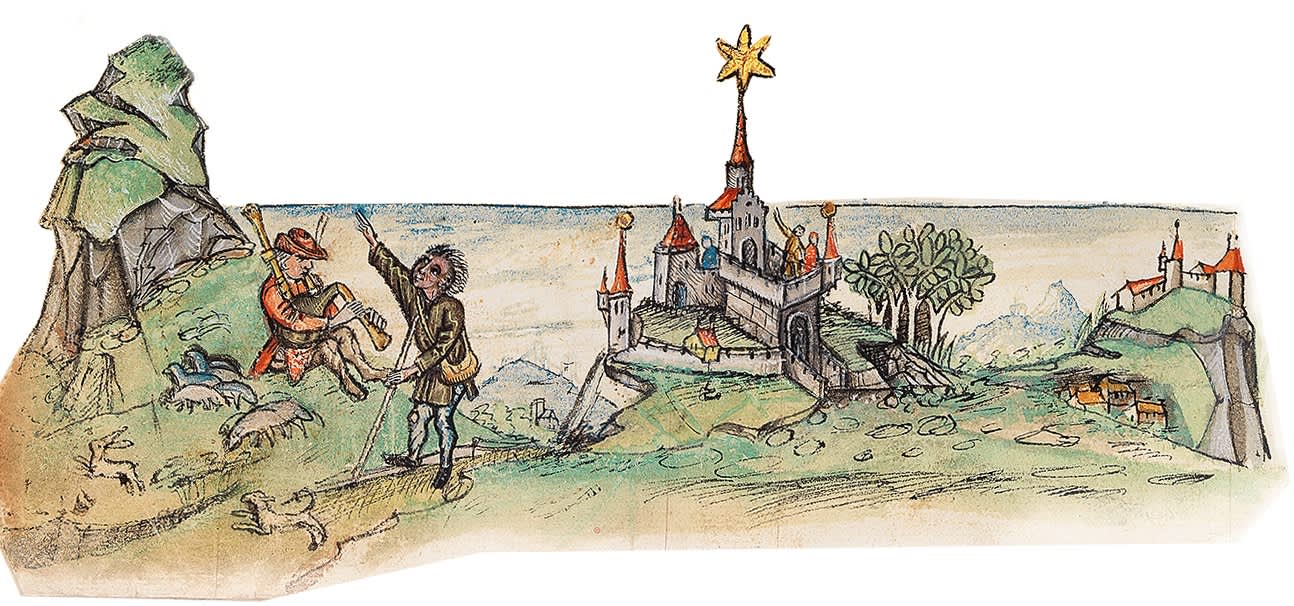 The birth and especially the resurrection of Christ are the most important festive days for Christianity. They form the beginning and the end of the winter cycle during the ecclesiastical year. Many medieval liturgical books revolve around the celebration of saintly feasts throughout the year. Here we encounter a beautiful Swiss-German Breviary from the 15th century with a great number of decorated initials and a glorious page that tells the story of Christ's nativity in an entertaining and endearing way.
The birth and especially the resurrection of Christ are the most important festive days for Christianity. They form the beginning and the end of the winter cycle during the ecclesiastical year. Many medieval liturgical books revolve around the celebration of saintly feasts throughout the year. Here we encounter a beautiful Swiss-German Breviary from the 15th century with a great number of decorated initials and a glorious page that tells the story of Christ's nativity in an entertaining and endearing way. -
Art as Therapy
Lesson Learned: What an Artwork Can Teach You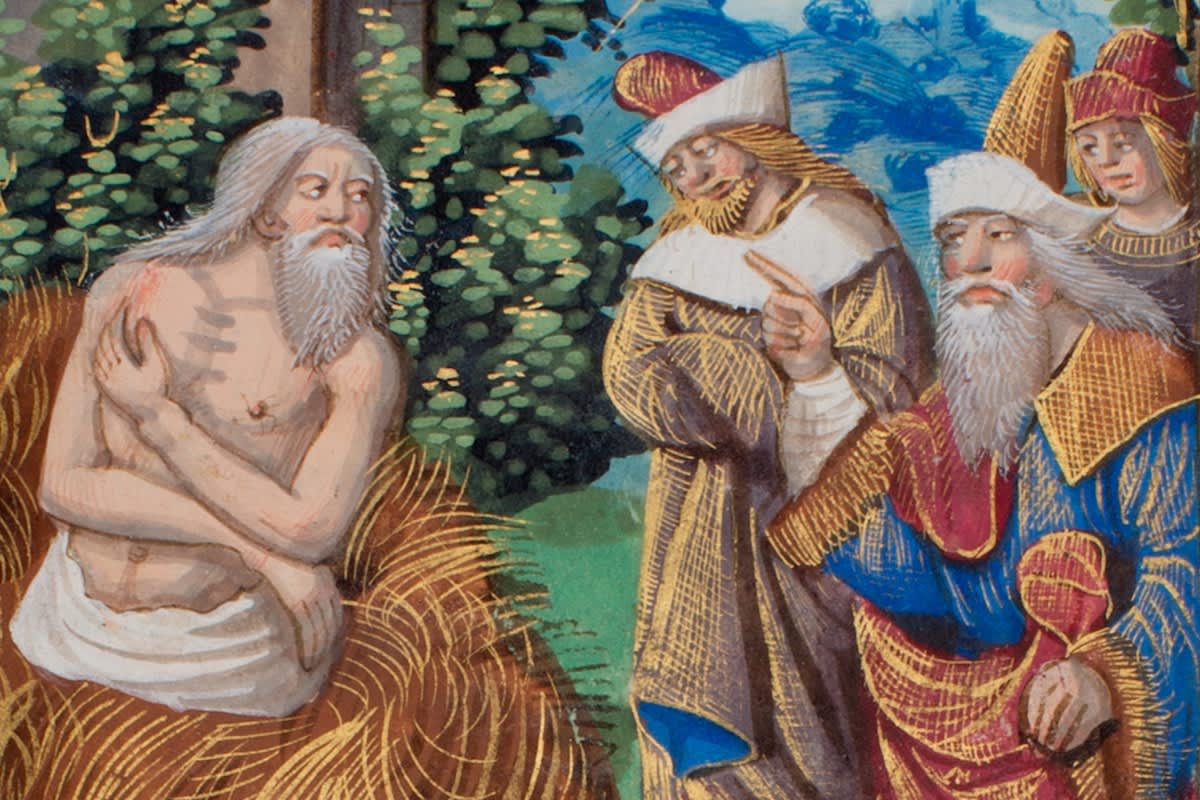
This year, our exhibition at Frieze Masters has an unusual theme. Inspired by Alain de Botton’s and John Armstrong’s book Art as Therapy, the exhibition will include a thematic display that focuses on the emotions that the artworks convey, or on life lessons to be learned from the works. Loosely based on the ideas from the book and the teachings of The School of Life, some of the thematic cases will show artistic depictions of life skills, such as resilience, curiosity, and virtue.
-
Mythos: Antiquity forever, forever Antiquity - 2
More common ground for Stephen Fry and Raphael de Mercatellis: the story of Yo and Argus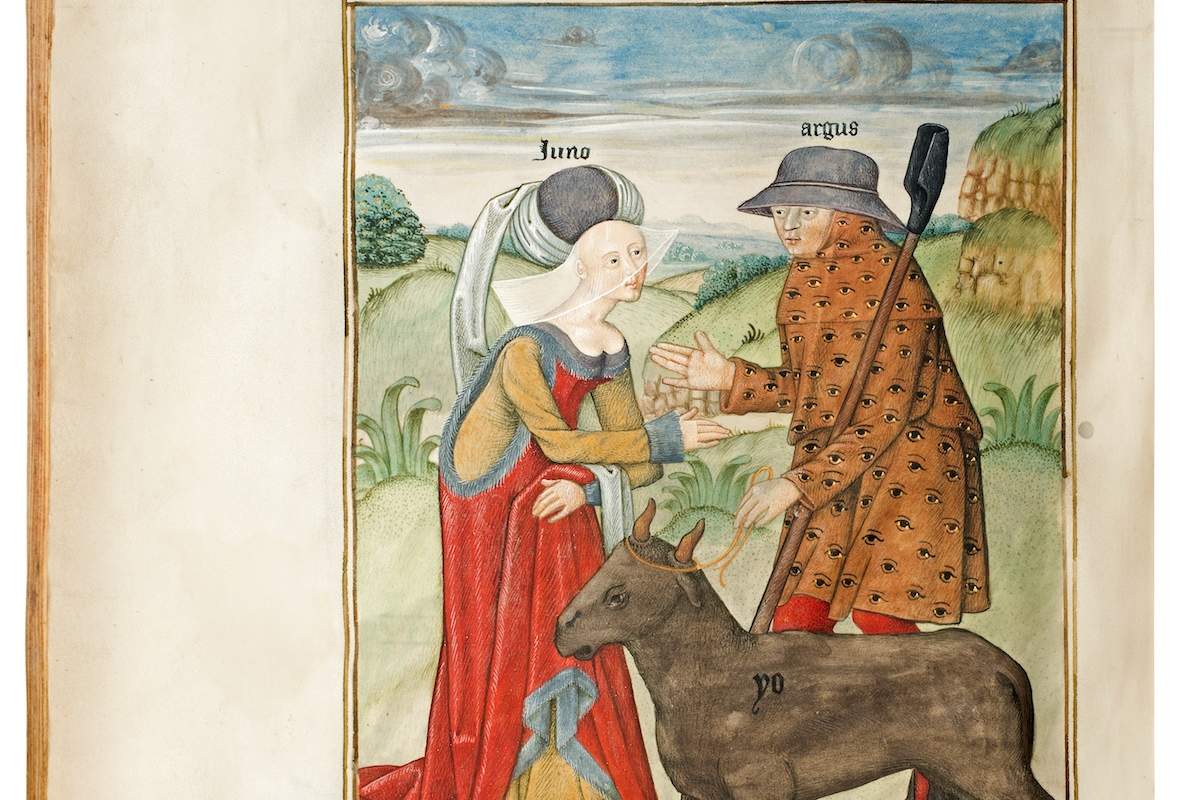 Juno, Argus and Yo as depicted here, tells us the fate of mortals in the hand of the gods of Antiquity.
Juno, Argus and Yo as depicted here, tells us the fate of mortals in the hand of the gods of Antiquity.Two miniatures in the manuscript made for Raphael de Mercatellis (see previous blog post) tell the mythological story of Yo and her warder Argus (a story told by Ovid [d. 17 CE], Metamorphoses I: 601-788). The illustrations show that after Jupiter fell in love with Yo, he turned her into a heifer to conceal her from the jealousy of his wife Juno. Juno then set the herdsman Argus, who had 100 eyes all over his body, to guard Yo.
Stephen Fry also lets us follow Zeus-Jupiter in this example of one of his extra-marital escapades, when both he and his wife Hera-Juno bring about a terrible fate to the innocent protagonists Argus and Yo.
Argus was a loyal follower of Hera-Juno. He also possessed a very special gift, which made him a perfect guardian of Yo. He had a hundred eyes…. Obedient as ever to Hera's will, he stationed himself in the field, fixed fifty eyes on Yo and let the other fifty range independently around and up and down, on the lookout for marauders. … Zeus knew his limits of his own cunning, however, so he called upon the wiliest and most amoral rogue on Olympos to aid him. Hermes-Mercury understood right away what needed to be done…. For two hours he played (a set of pipes) and he sang. The music, the afternoon heat, the scent of the poppies, lavender and wild thyme, the soft lapping and purling of a nearby stream - slowly Argus's eyes started to close, one by one. …. With Argus dead, Juno, who had seen what happened, sent down a gadfly which stung Yo so painfully and persistently that she bucked and screamed and galloped away, far from Zeus's reach. (Fry 2017, pp. 190-192).
-
Mythos: Antiquity forever, forever Antiquity - 1
Common ground for Stephen Fry and Raphael de Mercatellis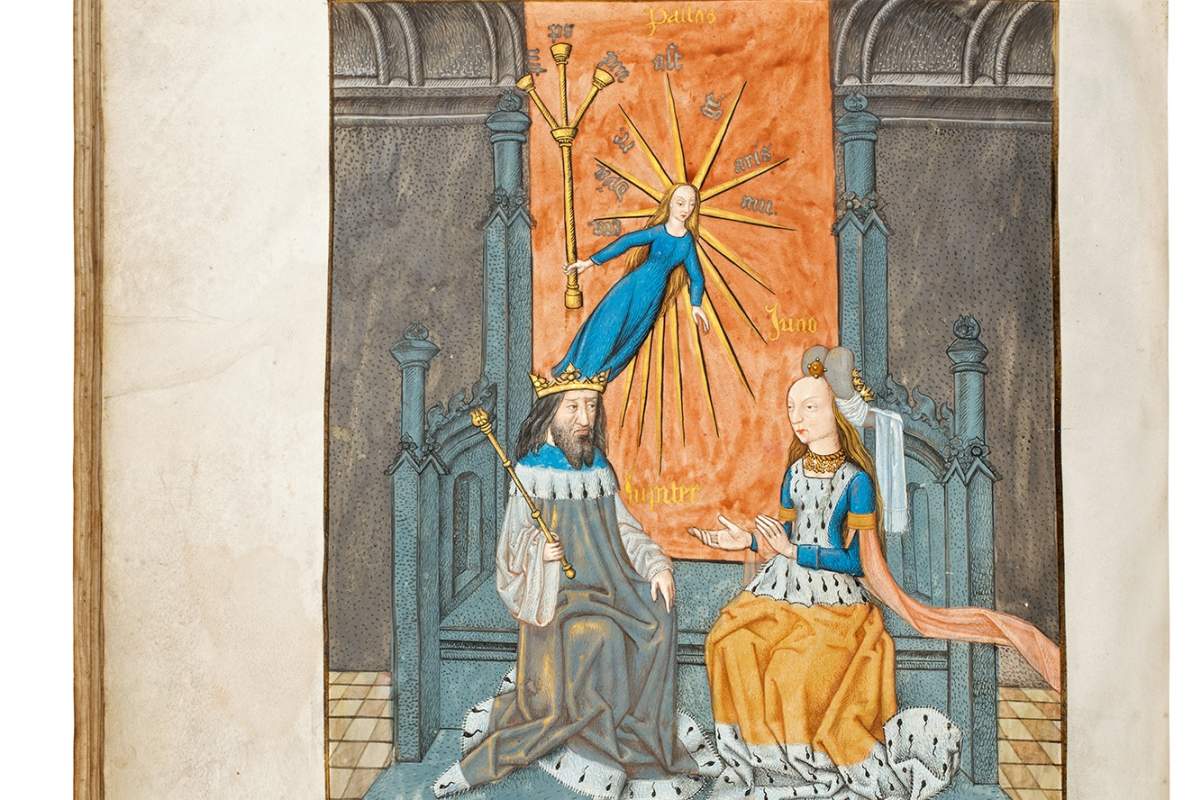 Birth of Pallas as illustrated for Raphael de Mercatellis, Bruges, ca. 1500
Birth of Pallas as illustrated for Raphael de Mercatellis, Bruges, ca. 1500For centuries, books have been written to share knowledge, inspiration, and discoveries. What many of us may not realize is that the Middle Ages determined what texts were handed down from Antiquity onwards. Had it not been for the scribes and patrons of late Antiquity and the Middle Ages, the entire literature of Greece and Rome would have perished. Medieval illuminated manuscripts gave stature to these ancient texts and thus contributed, to a large extent, to their preservation.
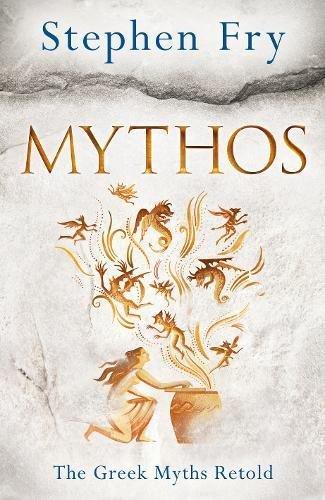
Last November, Stephen Fry, the famous British comedian, actor, long-time quizmaster, as well as successful author, published a retelling of stories that the ancient Greeks invented about the birth of the universe, their gods, and the creation of humankind (Michael Joseph - Penguin Books 2017).
As a child, Stephen Fry fell in love with these stories, which have never left him since. His lively, funny, and erudite book conveys this passion for Greek-Roman myths, which the author shares with numerous predecessors as well as contemporaries. One such a "predecessor" is the Flemish bibliophile, Raphael de Mercatellis, and here we present a medieval illustration from his library that attests to a myth also in Fry's book (we give here only the Latin names, not those in Greek).
-
An almost forgotten skill
Austrian chained binding in cuir-ciselé technique
The present beautiful and well preserved old binding from the first half of the 15th century is not only a magnificent example of the rare and sublime technique of cuir-ciselé (carved leather), but also still has its original chain with which the book was attached to its lectern in the library.
-
Chronique universelle
The world's history as French history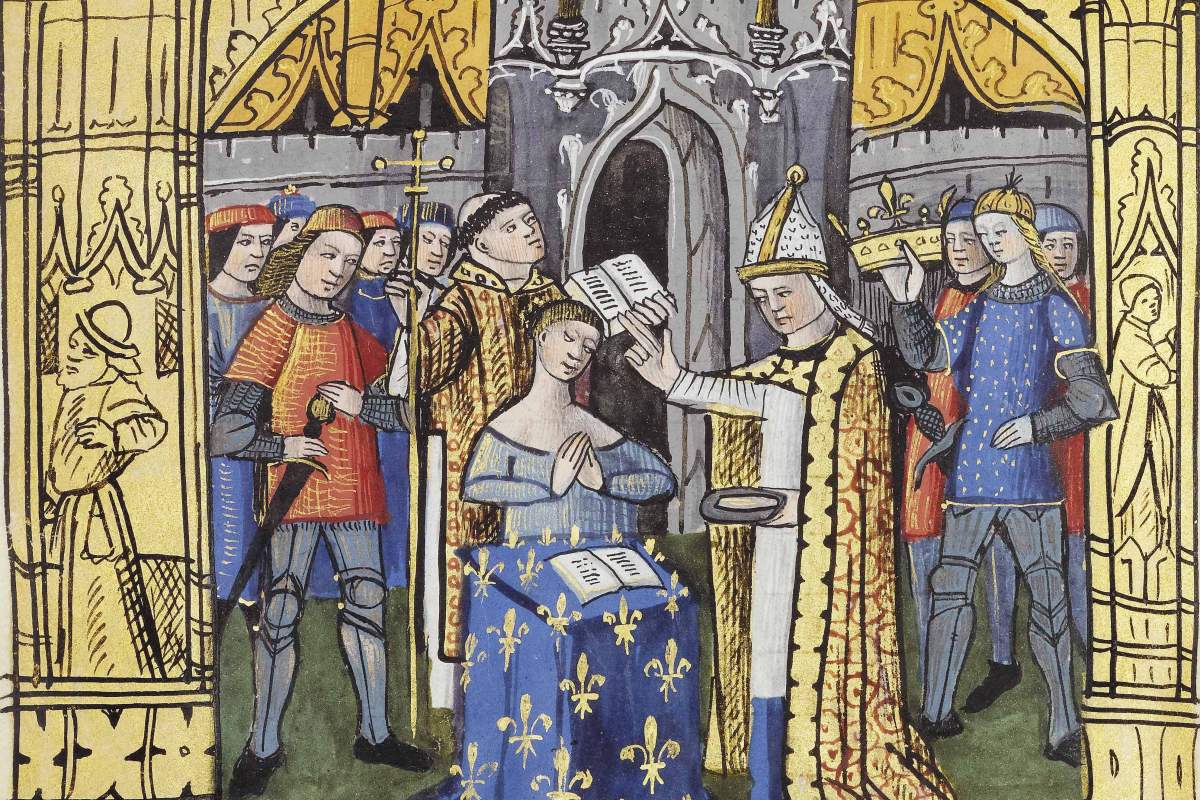
Medieval French "world" chronicles often recount history as a fairly direct line from biblical history, through ancient battles in Troy and Rome, to the foundation of Christian France, and up to the time in which the history was written.
-
Verkehrte Welt
These foolish things... Groteske Wesen aus einem Pariser Stundenbuch
Groteske Wesen aus einem Pariser StundenbuchWie viele von Ihnen wissen oder sogar direkt miterleben, befinden wir uns seit heute früh vier Uhr in Basels närrischer Zeit. „Frau Fasnacht“ regiert die nächsten drei Tage und in der Innenstadt, wie auch vor der Tür des Antiquariats Dr. Jörn Günther marschieren Cliquen musizierend unermüdlich auf und ab, und halten nur gelegentlich an, um sich bei einem Glas oder mit einem Teller heißer Mehlsuppe zu stärken.
Das Thema der „verkehrten Welt“, wo geltendes Recht auf den Kopf gestellt wird und diejenigen das Sagen haben, die sonst gewohnt sind, zu dienen, geht bereits auf die Antike zurück. Auch das Austreiben des Winters, der Dunkelheit und der bösen Geister hat von alters her Tradition.
-
Distinguished Patrons
Duyst van Voorhout, founders of a dynasty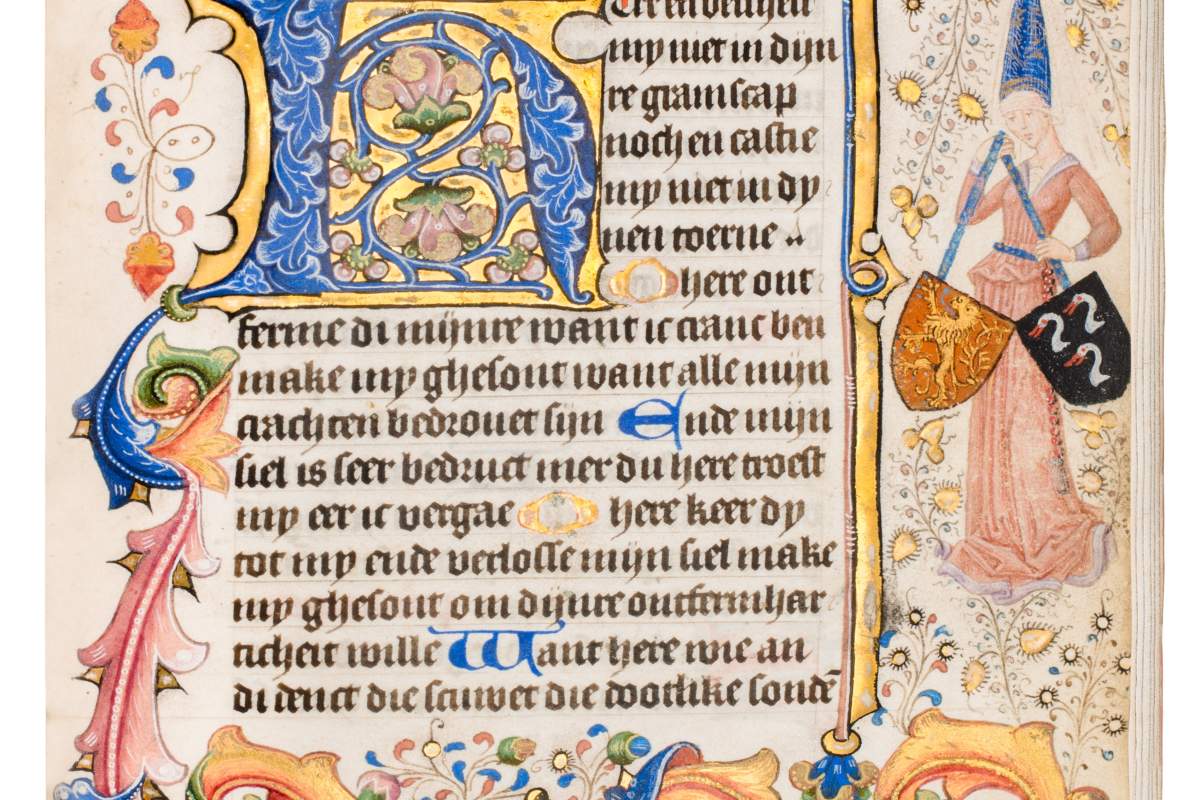 Arms Duyst van Voorhout
Arms Duyst van VoorhoutNot often, unknown Dutch manuscripts turn up that can be identified by the coats of arms of their noble patrons. A remarkable Book of Hours made in Delft, contains, on three pages, the coats of arms of Hendrick Nagel van Voorhout and Immesoet Duyst. Both husband and wife descend from old Delft families going back to the early 14th century. They are known as brewers, church master, aldermen, and burgomaster. Hendrick and Immesoet count as the founders of the Duyst van Voorhout family.




